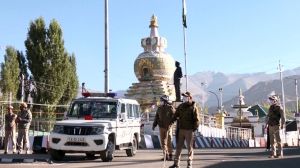Green clearance for Bawana waste-to-energy plant obtained after ‘false’ statements, residents allege
The matter has been listed for hearing on November 19
 Residents’ protest was launched last December (Express Photo)
Residents’ protest was launched last December (Express Photo)Residents of Sanoth village in northwest Delhi’s Bawana have told the National Green Tribunal (NGT) that the Centre’s environmental clearance for the Jindal Group’s 30 megawatt waste-to-energy plant was obtained through “false and misleading information”.
According to the Jindal Group, the Jindal Urban Waste Management (Bawana) Ltd plant will process about 3,000 tonnes of municipal solid waste per day using refuse-derived fuel (RDF) incineration technology.
The project is a public-private partnership with the Municipal Corporation of Delhi (MCD) on a 15-acre plot in the Delhi State Industrial and Infrastructure Development Corporation (DSIIDC) industrial area in Bawana.
The Union Environment Ministry granted environmental clearance (EC) to the proposed waste-to-energy (WTE) plant in June this year. This will be the fifth such facility in Delhi.
In a petition filed before the NGT, the have residents alleged that agents of the company “deliberately concealed information and provided misleading information which is material to the decision-making process”.
The petition alleged that residents of JJ Colony, Bawana, were misled into signing letters that were shown as public consent, after being told that “a new company is being set up, which will provide some employment, and the property prices will increase; but nothing [was said] about the health and environmental impacts of the plant”.
The Jindal Group did not respond to phone calls and messages requesting a comment on the allegations.
According to the plea, the plant site lies within 500 metres of dense human habitation, including JJ Colony, DDA Flats in Narela, and Bawana Sector 2. This is in violation of guidelines issued by the Central Pollution Control Board (CPCB) in 2019, which require a 500-metre buffer zone around waste-processing facilities.
The petition has alleged that the Ministry of Environment, Forest and Climate Change (MoEFCC) and the Expert Appraisal Committee (EAC) had ignored the committee’s own 2023 observation that the site was “very close to civil colonies”, and that the project proponent should “revisit the proposal in terms of its capacity and project site location”.
Residents of the area have been holding a sit-in protest against the project since the end of last year. The Delhi Pollution Control Committee (DPCC) held a public hearing on December 27, 2024, which did “not comply with the requirements of the EIA Notification 2006” and “overlooked the strong public opposition to the manner in which the public hearing was being conducted”, the petition before the NGT states.
The matter has been listed for hearing on November 19.
The Environment Impact Assessment (EIA) notification, issued in 2006, laid down a four-stage process of obtaining prior environmental clearance (screening, scoping, public consultation, and appraisal) for all new projects.
According to the petition, “over a thousand people had gathered in the vicinity of the public hearing venue with the intent to participate in the hearing but were unable to reach the venue”.
The hearing, which was scheduled at the project site, was moved to Prakash Garden in Sanoth village, where residents waited for hours, only to be told the event had been moved back to its original venue.
According to the villagers, despite the confusion over the venue and the rain that day, their requests to postpone the hearing were ignored.
The presentation was allegedly inaudible, their opportunities to object were allegedly “severely curtailed”, and many were unable to submit written representations. The minutes were read out but they were “not audible”, objections were not recorded, and the hearing was “abruptly concluded”, the plea states.
Bawana is one of 13 air-pollution hotspots identified by the Delhi government. It already has a 24 MW WTE plant, whose capacity is sought to be expanded to 60 MW, besides other red-category industries and the Bhalswa landfill. Residents say adding a new incineration plant to the area would worsen the local air quality and jeopardise their health.
WTE plants burn municipal waste to generate heat and electricity and, in the process, release hazardous pollutants such as dioxins and furans, which can cause cancer and reproductive disorders, and damage to the immune system. The process also produces nitrogen and sulphur oxides, particulate matter, and heavy metals such as cadmium and mercury.
Following directions issued by the NGT in 2020, Environment Ministry officials and an expert from IIT Delhi carried out a joint inspection at the Okhla, Ghazipur, and Bawana WTE plants, and found exceedances of pollutants including dioxins, furans, hydrochloric acid and particulate matter.







